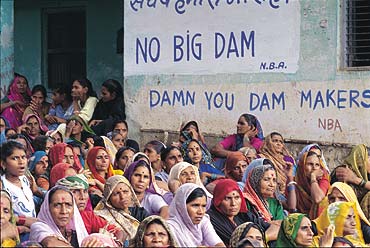Accaparramento dell'acqua in India: la Valle del Narmada è in pericolo.
Uno degli esempi più sconcertanti di accaparramento dell’acqua è sicuramente quello effettuato attraverso la costruzione di dighe, un fenomeno molto diffuso in India. Qui infatti sono in costruzione migliaia di dighe che serviranno a generare energia. Nella Valle del Gujarat è in costruzione la Sardar Sarovar Dam che fa parte del Narmada Valley Development Plan. Si tratta di un progetto che prevede la costruzione di 30 grandi dighe, 135 dighe di media grandezza e 3000 dighe di piccole dimensioni. La Narmada Bachao Andol (movimento per la salvezza de fiume Narmada) prevede che una volta terminata la costruzione la Sardar Sarovar Dam sommergerà circa 200km2 colpendo 250,000 persone e 242 villages (33 nello stato di Maharashtra, 190 in quello di Madhya Pradesh, e 19 nello Gujarat). Va ricordato che l’impatto del watergrabbing attraverso la costruzione di dighe è enorme, non solo perché vengono allagati interi villaggi e terre coltivate ma anche perché la costruzione di un sistema di dighe minaccia la biodiversità della regione colpita: l’habitat di molte specie animali e vegetali viene distrutto. Inoltre le dighe modificano i flussi d’acqua diretti a valle danneggiando attività come la pesca e l’agricoltura perché bloccano il limo privando le terre a valle dei necessari nutrimenti. L’accesso ai fiumi (fondamentali vie di trasporto, fonti di acqua e cibo) viene spesso vietato per non compromettere la produttività dell’impianto; le comunità vengono così private delle risorse naturali necessarie alla loro sussistenza. Un’ ulterioire elemento di criticità è legato al fatto che le dighe contribuiscono ad esacerbare il processo di erosione nonché ad aumentare il rischio di frane. A questo va aggiunto che la zona Himalayana Indiana è da considerarsi ad alto rischio sismico e questo ha forti ripercussioni sulla sicurezza delle dighe e di conseguenza sulla sicurezza delle aree e dei villaggi circostanti. Secondo i dati forniti dal South Asia Network on Dmas Rivers and People (SANDRP) le grandi dighe contribuiscono all’emissione di gas serra in maniera piuttosto significativa; in particolare l’emissione di gas metano dovuta alle grandi dighe indiane costituisce più del 18% del totale delle emissioni di gas serra in India. Oltre agli impatti sopracitati vanno menzionati anche gli impatti socioculturali di tali opere: Le regioni bagnate dal fiume Narmada sono abitate da gruppi tribali e i grandi lavori infrastrutturali comportano il dover spostare e reinsediare centinaia, se non migliaia, di persone in territori già abitati da popolazioni con tradizioni e stili di vita a volte molto diversi; questo può creare conflitti etnici. Va inoltre ricordato che il Narmada è un fiume sacro è ha quindi un forte valore identitario per i locali essendo legato alla loro vita spirituale. Nonostante la Corte Suprema Indiana si sia espressa i più occasioni affinché le persone colpite ricevessero le compensazioni e riparazioni previste dalla legge, il Governo ha provveduto al reinsediamento di molte famiglie senza però concedergli alcun titolo formale sulla nuova terra. Secondo il Movimento per la Salvezza del Fiume Narmada, inoltre, il governo ha assegnato a tali famiglie terreni non coltivabili mentre molte non hanno ricevuto alcuna forma di riparazione perché non possedevano il titolo formale sulla terra.
Location
India, Narmada Valley https://www.google.co.in/maps/place/Sardar+Sarovar+Dam,+Gujarat+393155/@21.8300165,73.7484661,717m/data=!3m1!1e3!4m5!3m4!1s0x39601e75f68e3dd3:0x60d783d6475b6669!8m2!3d21.8305054!4d73.7485212
Environmental impact
- Land degradation (e.g. drought, soil contamination, erosion and desertification)
- Biodiversity loss – Ecosystem destruction
- Depletion of natural resources (fossil and mineral, forest, water, etc)
- Hazards related to extreme weather events – natural disaster
- Alteration of landscape aesthetics and built heritage
Ethical/ legal issues
- Life and personal security
- Health and well-being
- Equality before the law and protection by the law (including marginalized and discriminated groups because of colour, race, gender, disability, descent, economic status, age, etc.)
- Indigenous land, culture and rituals
- Access to public goods/ resources and products
- Democratic participation to decision-making on community and national affairs
Information sources & materials
Scientific/ academic reports
http://www.nvda.in/pdf/vision2015.pdf
https://www.internationalrivers.org/sites/default/files/attachedfiles/fact_finding_report_ssd2015.p
Online books and newspaper, magazine, encyclopedia, or blog articles
http://www.bbc.com/news/world-asia-india-27828109
https://ceasefiremagazine.co.uk/notes-struggle-narmada-valley-india/
https://www.internationalrivers.org/blogs/328-18
Other Sources & Materials
http://cdca.it/en/archives/12163
http://www.sardarsarovardam.org/
Contributor(s)
Elisa Veritti, giustizia.ambientale@cevi.coop, CeVI, Italy



Home › Forums › Water Grabbing in India puts Narmada Valley in danger.